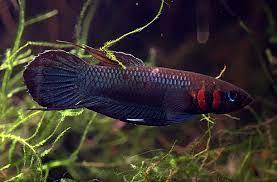Betta Foerschi

Credit: Seriously Fish
Hailing from the blackwater environments of Southeast Asia, Betta foerschi boasts striking iridescent coloration and offers a fascinating look at wild betta species. This post is meant to help create a thriving environment for them.
Understanding the Needs of Betta foerschi
- True Blackwater Fish: Like other species from these habitats, Betta foerschi require soft, acidic water. Using reverse osmosis (RO) water and a product for blackwater setups is usually essential. Aim for:
- pH: 5.0-6.5
- Hardness: Very soft to negligible (GH 0-5, KH 0-3)
- Temperature: 73-79°F (23-26°C)
- Tank Setup: Start with at least 5 gallons, though larger is always preferred. Create a densely planted environment with live or high-quality silk plants, driftwood, and Indian almond leaves. Gentle filtration, like that from a sponge filter, is crucial to avoid strong currents.
- Cover is Key: Betta foerschi naturally inhabit areas with dense surface vegetation. Include floating plants or driftwood pieces that break the surface, offering resting areas near atmospheric air access.
Feeding Your Betta foerschi
These wild bettas are carnivores. Provide a varied diet for optimal health:
- Live Foods: Their favorites include bloodworms, brine shrimp, and daphnia. These should be staples in their diet.
- Frozen Foods: Frozen versions make good substitutes if live foods are unavailable.
- Pellets: Choose high-quality betta pellets with minimal fillers and offer them sparingly as an occasional supplement.
Temperament and Tank Mates
- Males: Betta foerschi males should generally be kept alone. They will exhibit territoriality and aggression toward other males.
- Females: Can sometimes coexist peacefully in a very large, heavily planted tank. However, aggression can still occur, requiring close monitoring.
- Community Tanks: Proceed with extreme caution. Only consider this if you have extensive aquarist experience. Potential tank mates must tolerate identical water conditions and be small, peaceful, slow-moving fish that won’t intimidate the betta. Researching options thoroughly are vital.
Breeding Betta Foerschi
Breeding Betta foerschi is a project best suited for experienced betta keepers. Here’s an overview of the process:
- Separate Breeding Tank: Set up a dedicated breeding tank with the ideal water parameters.
- Conditioning the Pair: Feed high-quality live foods to encourage breeding readiness.
- Paternal Mouthbrooding: Betta foerschi are mouthbrooders. The male will hold eggs and fry in his mouth for incubation.
- Fry Care: Fry are incredibly tiny and sensitive, requiring live cultures of microscopic foods.
Additional Notes
- Availability: Betta foerschi are rarer in the aquarium trade, so you may need to find a breeder specializing in wild bettas.
- Sensitivity: Be attentive to water parameters. Betta foerschi can be less forgiving of fluctuations than some selectively bred bettas.
- Observation is Key: Monitor behavior carefully to ensure your Betta foerschi is thriving and adjust care as needed.
